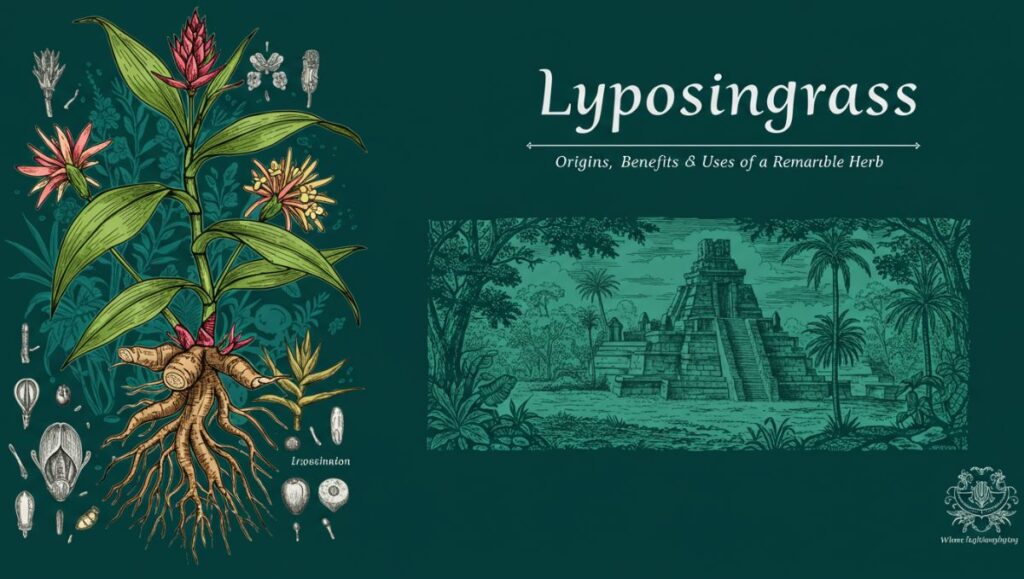Herbal remedies have been part of human tradition for centuries. Among them, lyposingrass has been gaining attention as a versatile plant with potential health benefits, culinary uses, and cultural significance. While not as widely known as herbs like basil or coriander, lyposingrass is valued in certain regions for its flavor, nutrients, and natural healing properties. This article explores its origins, characteristics, uses, and impact on human well-being.
Origins and Background of Lyposingrass
Historical Roots
Lyposingrass is believed to have originated in subtropical regions, where it grew wild and was harvested by local communities for food and medicine. Traditional healers used it as a natural remedy for common ailments, including digestive troubles, fatigue, and inflammation. Over time, knowledge of lyposingrass spread through oral traditions, eventually making its way into folk medicine and local cuisines.
Botanical Characteristics
Lyposingrass is a perennial grass-like plant with slender green stalks and aromatic leaves. It grows in clumps, reaching about one meter in height, and thrives in warm, sunny environments. Its leaves carry a subtle citrus-like fragrance, making it both useful for cooking and appealing in herbal teas.
Nutritional Profile of Lyposingrass
Like many green herbs and grasses, lyposingrass offers a rich array of vitamins, minerals, and antioxidants. Some of its most notable nutritional components include:
-
Vitamin C: Supports immunity and skin health.
-
Vitamin A: Essential for eye function and cell repair.
-
Calcium and Magnesium: Important for bones, muscles, and heart rhythm.
-
Antioxidants: Help neutralize harmful free radicals in the body.
-
Dietary Fiber: Supports healthy digestion and gut function.
This nutrient combination makes lyposingrass a beneficial addition to a balanced diet.
Health Benefits of Lyposingrass
Digestive Support
Traditionally, lyposingrass tea has been consumed to ease indigestion, bloating, and stomach cramps. Its natural compounds help stimulate enzyme production, supporting smoother digestion.
Anti-inflammatory Properties
The plant contains active compounds believed to reduce inflammation. Consistent use may help people manage joint pain, arthritis, and other inflammatory conditions.
Natural Detoxifier
Lyposingrass is often valued for its cleansing effects on the body. It may help flush out toxins through the kidneys, supporting overall detoxification.
Energy and Vitality
Communities that use lyposingrass often consume it as a tonic to reduce fatigue. Its natural nutrients boost energy levels and improve mental clarity.
Immune Support
With its antioxidants and vitamins, lyposingrass strengthens the body’s defenses against infections and seasonal illnesses.
Lyposingrass in Traditional Medicine
Folk Practices
In rural villages, healers brewed lyposingrass into teas or prepared poultices for external use. It was applied to minor wounds to prevent infection and consumed to improve respiratory health.
Ayurveda and Herbal Systems
Though less common in mainstream herbal texts, lyposingrass has been mentioned in regional adaptations of Ayurveda, where it is classified as a balancing herb that cools excess body heat.
Modern Herbalism
Contemporary herbalists are beginning to explore the plant for its adaptogenic qualities, which may help the body resist stress and maintain balance.
Culinary Uses of Lyposingrass
Flavor Profile
Lyposingrass has a mild, citrusy flavor with hints of lemongrass and green tea. Its refreshing aroma makes it suitable for both savory and sweet dishes.
Cooking Applications
-
Teas and Infusions: The most common use, brewed into calming herbal teas.
-
Soups and Curries: Leaves are added to flavor broths and stews.
-
Rice and Grain Dishes: Used to infuse grains with subtle fragrance.
-
Desserts: Occasionally incorporated into syrups or sweet beverages.
Beverages and Infusions
In wellness communities, lyposingrass is a popular base for detox waters, herbal cocktails, and cold infusions that support hydration and vitality.
Lyposingrass in Modern Wellness Trends
In today’s health-conscious world, lyposingrass is being rediscovered as a natural wellness ingredient. Herbal tea blends, powdered supplements, and essential oils derived from lyposingrass are now appearing in holistic markets.
Fitness and Detox Programs
Its mild detoxifying qualities make it a popular choice in fitness routines focused on cleansing and weight management.
Stress Relief
Many herbal practitioners recommend lyposingrass tea in the evening to promote relaxation and reduce anxiety.
Natural Skincare
Extracts of lyposingrass are also used in natural cosmetic products, where they may help soothe skin irritations and refresh the complexion.
Scientific Research and Future Potential
Though scientific studies on lyposingrass are still limited, initial research suggests potential in several areas:
-
Antioxidant activity: Could protect cells from oxidative stress.
-
Anti-inflammatory effects: May reduce chronic inflammation.
-
Antimicrobial potential: Could help combat harmful bacteria and fungi.
-
Metabolic benefits: May play a role in regulating blood sugar levels.
As interest grows, more research will likely uncover additional benefits of this versatile plant.
Growing and Harvesting Lyposingrass
Cultivation Conditions
Lyposin grass grows best in warm climates with well-drained soil and plenty of sunlight. It requires moderate watering and thrives in both home gardens and larger farms.
Harvesting Practices
Leaves are typically harvested once the plant reaches maturity, while younger shoots are prized for their tenderness. After harvesting, leaves can be used fresh, dried for storage, or distilled into oils.
Sustainability Considerations
As lyposin grass becomes more popular, sustainable farming methods are essential to preserve soil health and local ecosystems.
Cultural and Symbolic Importance
In some traditions, lyposin grass is considered a symbol of renewal and purity. Festivals and ceremonies often use it in rituals for cleansing and protection. Its refreshing aroma has also made it a popular choice in incense and natural air fresheners.
Practical Ways to Use Lyposingrass at Home
-
Daily Tea: Brew a soothing cup to start or end the day.
-
Cooking Ingredient: Add to soups, rice, or curries for a subtle flavor.
-
Aromatherapy: Use essential oils for relaxation.
-
Home Remedies: Apply cooled tea as a natural skin toner.
These simple applications show how easily lyposin grass can be integrated into everyday life.
Conclusion
Lyposingrass is more than just a plant—it is a bridge between tradition and modern wellness. From its origins in local folk practices to its growing role in global health trends, lyposingrass continues to prove its value as a versatile herb. Rich in nutrients, beneficial to digestion, supportive of immunity, and refreshing in taste, it offers a natural way to enhance both health and lifestyle.
As research advances and awareness spreads, lyposin grass has the potential to become a widely recognized herb in the world of nutrition and natural medicine. For those seeking balance, vitality, and a deeper connection to nature, this remarkable grass provides a meaningful solution.







